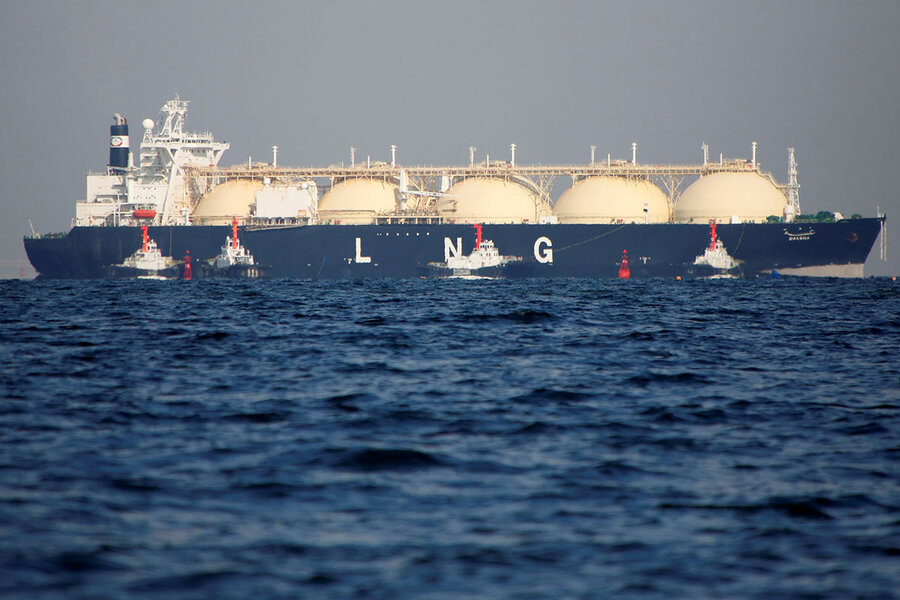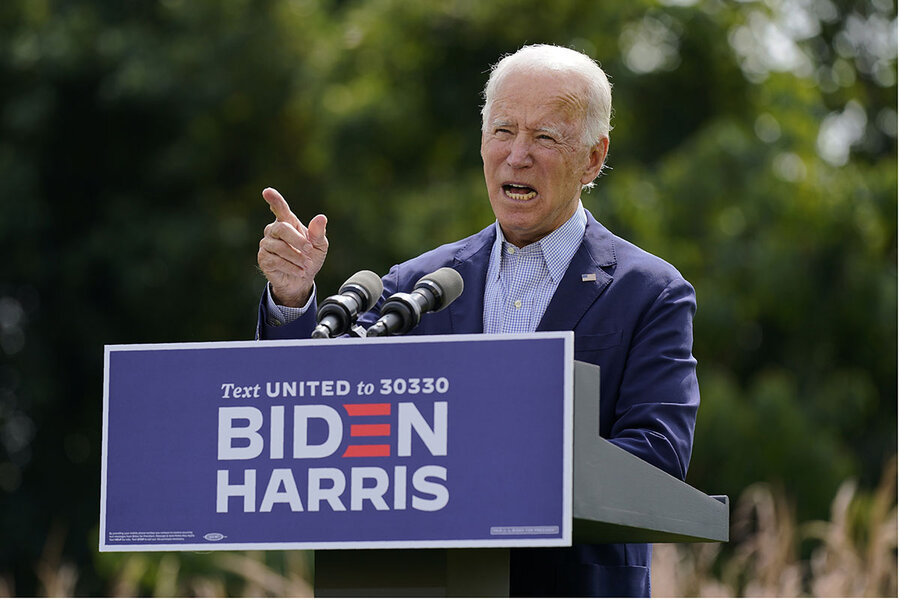By Simon Montlake
Proponents say liquefied natural gas is cleaner than coal when burned, and we shouldn’t make perfect the enemy of the good. Here’s why policy on the fuel would test Democrats under a potential Biden presidency.
Featuring Jordon Cove

For more than a decade, Susan Jane Brown has been battling to stop a natural gas pipeline and export terminal from being built in the backcountry of Oregon. As an attorney at the nonprofit Western Environmental Law Center, she has repeatedly argued that the project’s environmental, social, and health costs are too high.
All that was before this month’s deadly wildfires in Oregon shrouded the skies above her home office in Portland. “It puts a fine point on it. These fossil fuel projects are contributing to global climate change,†she says.
Jordan Cove, the $10-billion liquefied natural gas (LNG) project that Ms. Brown is trying to stop, has yet to break ground. But environmental lawsuits and permitting delays aren’t the only barriers. A calamitous crash in natural gas prices and a glut of LNG capacity have cast doubts over its commercial viability and, more broadly, the easy promise of converting abundant U.S. gas into a global commodity and geopolitical tool.
“There’s too much oil. There’s too much gas. There’s not enough demand,†says Clark Williams-Derry at the liberal-leaning Institute for Energy Economics and Financial Analysis.
Still, even if projects like Jordan Cove are shelved, several other LNG terminals on the Gulf Coast already have all their permits and are waiting to secure financing. Their expansion over the next five years would make the U.S. the world’s largest LNG producer, creating jobs at home and opening new markets in energy-hungry Asia.

Alex Milan Tracy/Sipa USA/AP/File Environmental protesters storm the Capitol in Salem, Ore., on November 21, 2019, to demand that the State reject proposals by Canadian energy giant Pembina for the Jordan Cove Energy Project which if approved would see the construction of a liquefied natural gas export terminal at the International Port of Coos Bay fed by an associated 229 mile Pacific Connector Gas Pipeline.
For a future Biden administration, that’s a wrinkle in any serious climate plan. Once built, these LNG plants would potentially lock in decades of heat-trapping emissions that are already hurling the planet toward a hotter, less stable future. “Once you build the infrastructure it’s there, and it gets run on a different economic basis than if it’s not there,†says Mr. Williams-Derry, who tracks the LNG industry. Is the economy running fast or slow? It depends where you look.
Proponents say natural gas is cleaner than the coal that it replaces both in the U.S., where it now produces around 40% of electricity, and in countries like India and China. That makes it a “bridge fuel†to a fully renewable energy future that hasn’t yet arrived, says Fred Hutchison, president and CEO of LNG Allies, an industry group. “Gas can continue to be part of a low-carbon energy system globally,†he says.
He predicts that LNG firms would be comfortable with a Biden presidency. “He’s got a great affinity for working people and labor, and labor is very much on board with regards to LNG,†he says.
On the campaign trail, Mr. Biden has gotten heat over his support for hydraulic fracturing, or fracking, which left-leaning Democrats oppose but which is seen as important for winning Pennsylvania, a battleground state in November’s election. Far less attention has been paid to where the oil and gas goes, and whether support for LNG exports is compatible with Mr. Biden’s clean-energy agenda and plans for tackling climate change.
“It’s not going to save the climate if we’re just exporting our emissions overseas,†says Collin Rees, a campaigner for Oil Change U.S., an environmental nonprofit.
Moderates feeling the heat
If elected, Mr. Biden has vowed to stop new drilling for oil and gas on federal land and in federal waters and to rejoin the 2015 Paris climate accord that President Donald Trump gave notice of quitting. He would reinstate Obama-era regulations of greenhouse gas emissions, including methane, the largest component of natural gas.
The Biden climate platform also states that all federal infrastructure investments and federal permits would need to be assessed for their climate impacts. Analysts say such a test could impede future LNG plants and pipelines, though not those that already have federal approval.
Climate change activists who pushed for that language say much depends on who would have oversight of federal agencies that regulate the industry. Some are wary of Biden’s reliance on advice from Obama-era officials, including former Energy Secretary Ernest Moniz, who is now on the board of Southern Company, a utility, and a former Obama environmental aide, Heather Zichal, who has served on the board of Cheniere Energy, an LNG exporter.

Patrick Semansky/AP Democratic presidential candidate and former Vice President Joe Biden speaks about climate change and wildfires affecting western states, on Monday, Sept. 14, 2020, in Wilmington, Delaware. The Biden climate platform states that all federal infrastructure investments and federal permits would need to be assessed for their climate impacts. Analysts say such a test could impede future LNG plants and pipelines, depending on the implementation.
In a letter sent earlier this month, Mr. Rees and other signatories urged Mr. Biden to ban “all fossil fuel executives, lobbyists, and representatives†from any future administration.
That Obama-era moderates are under fire over their climate bona fides is a measure of rising leftist clout in the Democratic coalition. It also reflects how the climate debate has shifted since Biden was in office, in response to extreme weather events and troubling scientific findings. This includes research into lifecycle emissions from natural gas production and methane leaks and flaring that muddies the argument that it’s a transition fuel to a carbon-free future.
“We’ve gotten more proof on the science that switching to gas is not enough,†says Mr. Rees.
The push for U.S. fuel exports
As vice president, Biden was part of an administration that pushed hard for global climate action while also promoting U.S. oil and gas exports to its allies and trading partners. As fracking boomed, Obama ended a 40-year ban on crude oil exports. In Europe, LNG was touted both as an alternative to coal and as strategic competition with Russian pipelines.
That much, at least, continued with President Trump. Under Energy Secretary Rick Perry, the agency referred to liquefied U.S. hydrocarbons as “freedom gas.â€
Mr. Trump has also championed the interests of coal, oil, and gas while denigrating the findings of government climate scientists. He rejected the Paris accord as unfair to the U.S. and detrimental to its economy, but has offered no alternative path to emissions cuts.
Still, Trump’s foreign policy has not always served the LNG industry: Tariffs on foreign steel drove up pipeline costs, and a trade war with China stayed the hand of Chinese LNG importers wary of reliance on U.S. suppliers.
Even his regulatory rollbacks could be a double-edged sword. By relaxing curbs last month on methane leaks, the U.S. has ceded ground to European regulators who are drafting emissions standards that LNG producers are watching closely. “That’s a precursor of fights that will be fought in all the rest of the developed world,†says Mr. Hutchison.
Indeed, some oil-and-gas exporters had urged the Trump administration not to abandon the tougher rules, since they undercut their claim to offer a cleaner-burning way of producing heat and electricity. “U.S. LNG is not going to be able to compete in a world that’s focused on methane emissions and intensity,†says Erin Blanton, a senior research scholar at the Center on Global Energy Policy at Columbia University.
Stepping on the gas
In July, the Department of Energy issued an export license to Jordan Cove’s developer, Canada’s Pembina Pipeline Corp. In a statement, Energy Secretary Dan Brouillette said the project would provide “reliable, affordable, and cleaner-burning natural gas to our allies around the world.â€
As a West Coast terminal, Jordan Cove offers a faster route to Asia where its capacity of 7.8 million tons of LNG a year could serve to heat more than 15 million homes. At its peak, its construction would also create 6,000 jobs, the company says, in a stagnant corner of Oregon.
But the project still lacks multiple local and state permits, and its biggest asset – a Pacific port – has become its biggest handicap, says Ms. Blanton. “They are putting infrastructure in a state where there’s no political support for the pipeline or the terminal, unlike in Louisiana or Texas,†she says.
Ms. Brown, the environmental lawyer, says she wants to see Jordan Cove buried, not just mothballed until natural gas prices recover. But she knows that it’s only one among many LNG projects and that others will likely get built, even if Biden is elected in November, despite growing evidence of the harm caused by methane emissions.
“I don’t see this country turning off the natural gas spigot anytime soon and I don’t see a President Biden doing that either,†she says. But she does expect a decisive shift on climate policy that could eventually force a reckoning for the U.S. energy sector.
“We can’t continue to pull fossil fuels out of the ground and put them in the air and expect to have a livable planet. It’s a nonstarter,†she says.
Simon Montlake is a reporter at the Monitor in Boston. He’s a former Monitor correspondent in Jakarta, Bangkok, and Beijing, where he covered political upheavals, civil wars, economic crises, natural disasters, and the Beijing Olympics. In addition to the Monitor, he has worked for The Economist and Forbes.
This article was published on September 17 at The Christian Science Monitor.
